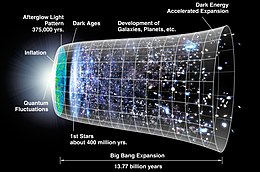BIG HISTORY
This article possibly contains original research.
Learn more
A diagram of the Big Bang expansion according to NASA
Artist's depiction of the WMAP satellite gathering data to help scientists understand the Big Bang
Big History is an academic discipline which examines history from the Big Bang to the present. Big History resists specialization, and searches for universal patterns or trends. It examines long time frames using a multidisciplinary approach based on combining numerous disciplines from science and the humanities,[1][2][3][4][5]and explores human existence in the context of this bigger picture.[6] It integrates studies of the cosmos, Earth, life, and humanity using empirical evidence to explore cause-and-effectrelations,[7][8] and is taught at universities[9] and secondary schools[10]often using web-based interactive presentations.[10]
According to historian David Christian, who has been credited with coining the term "Big History",[7][9][11] the intellectual movement is made of an "unusual coalition of scholars".[2] Some historians have expressed skepticism towards "scientific history" and argue that the claims of Big History are unoriginal.[12]Others support the scientific merit but point out that cosmology[13] and natural history[14] have been studied since the Renaissance, and that the new term, Big History, continues such work.
Conventional historyBig History5000 BCE to presentBig Bang to present7,000–10,000 years13.8 billion yearsCompartmentalized fields of studyInterdisciplinary approachFocus on human civilizationFocus on how humankind fits within the universeTaught mostly with booksTaught with interactive websites such as ChronoZoomMicrohistoryMacrohistoryFocus on trends, processesFocus on analogy, metaphorBased on a variety of documents, including written records and material artifactsBased on current knowledge about phenomena such as fossils, ecological changes, genetic analysis, telescope data






Comments
Post a Comment